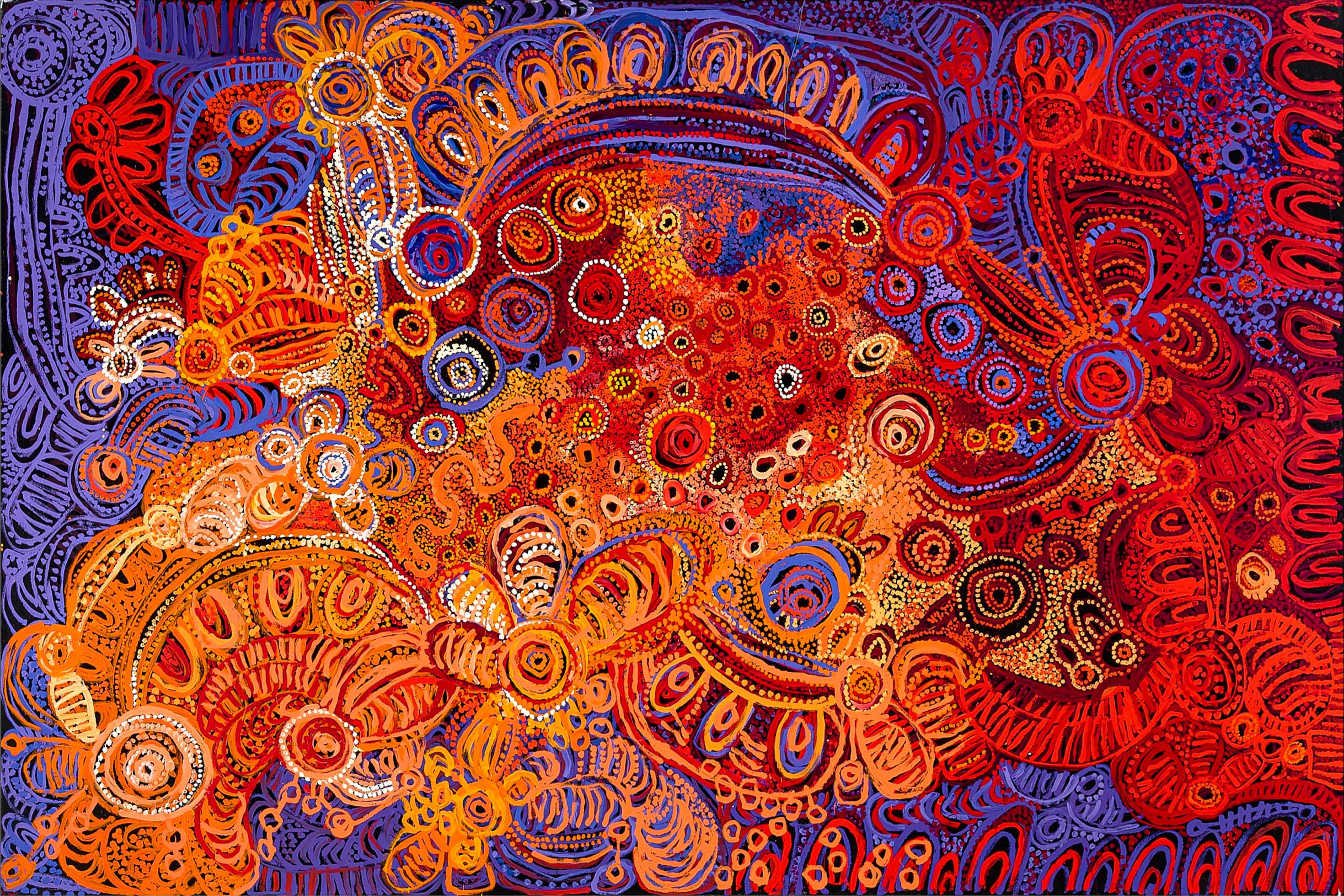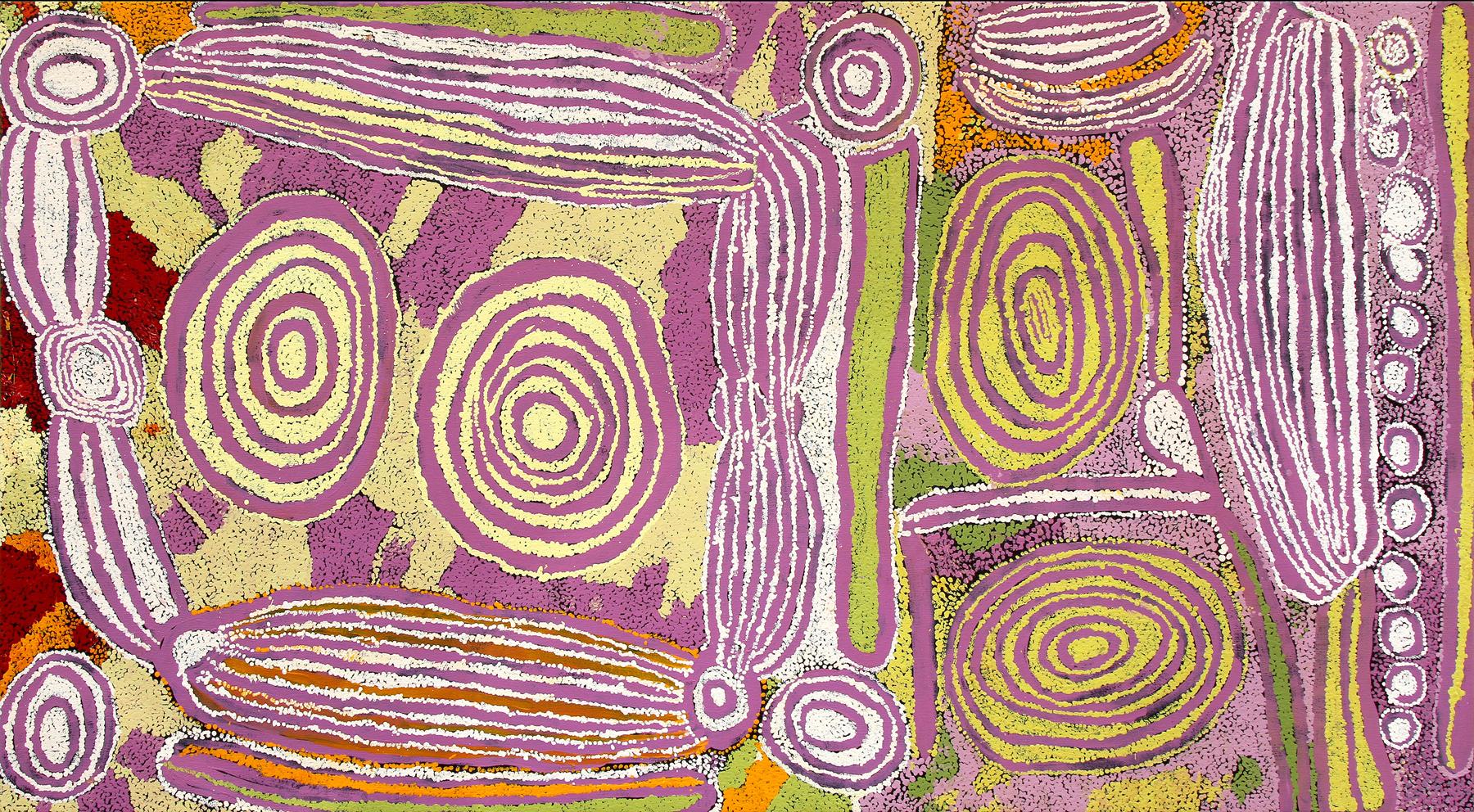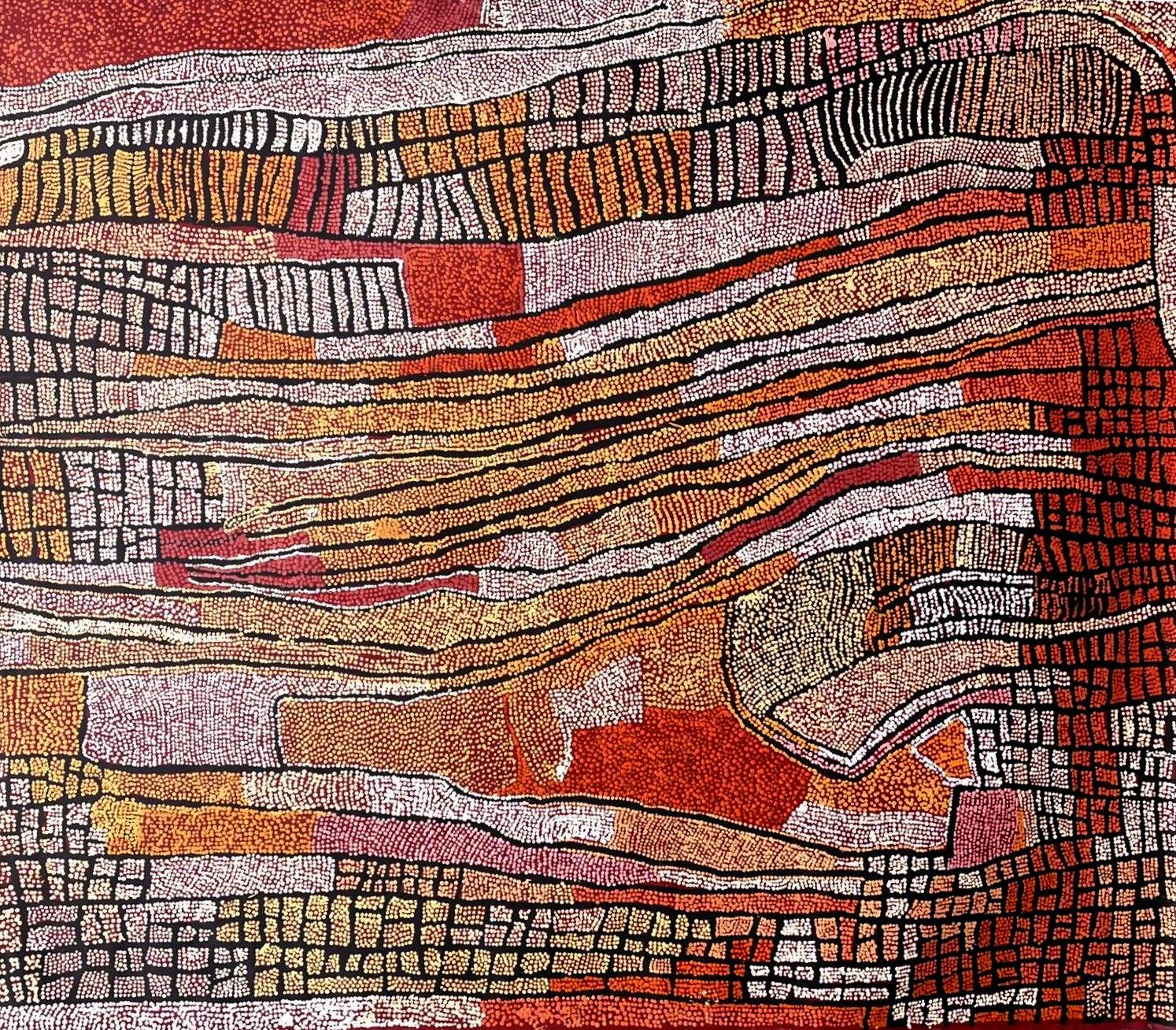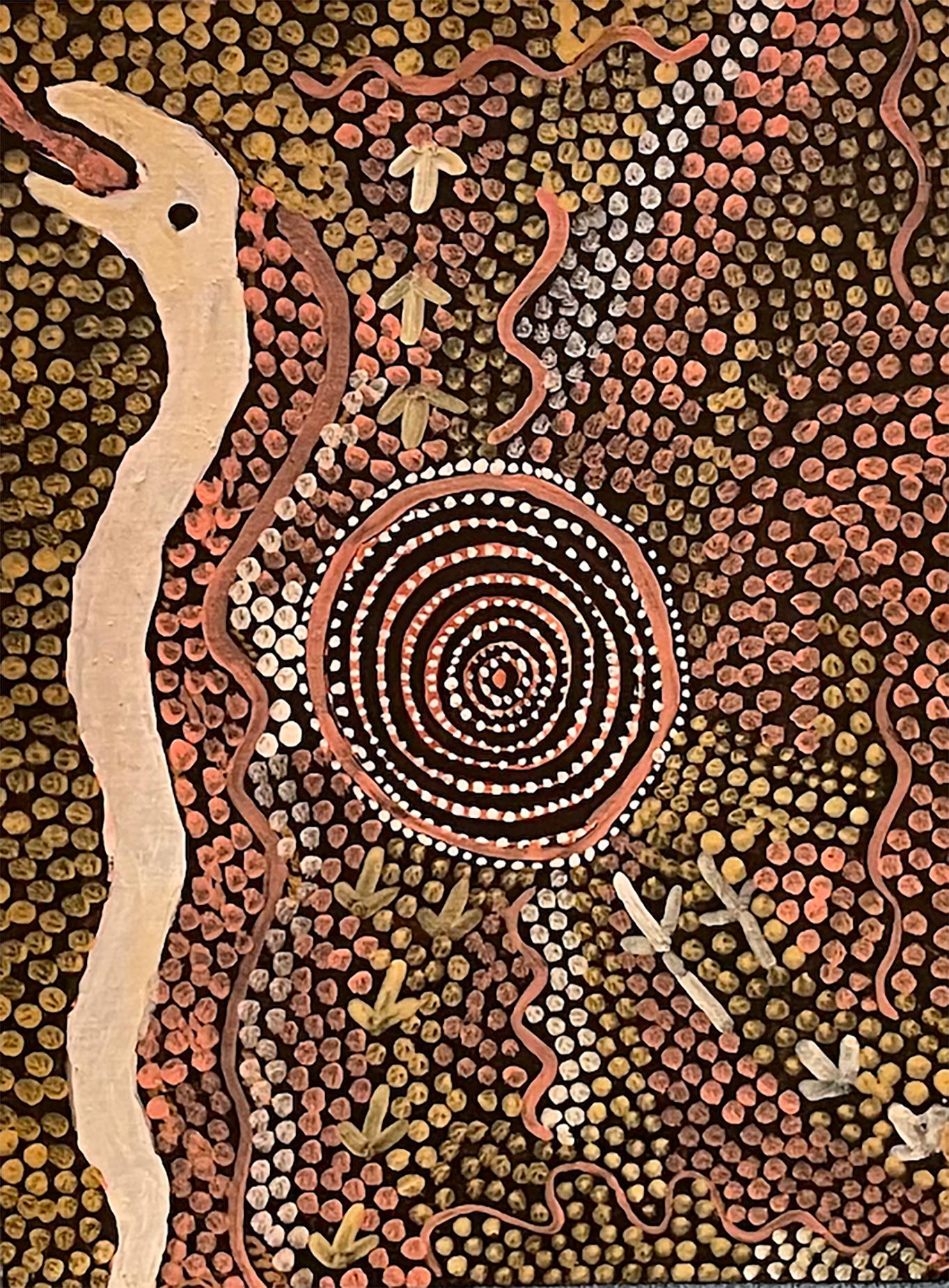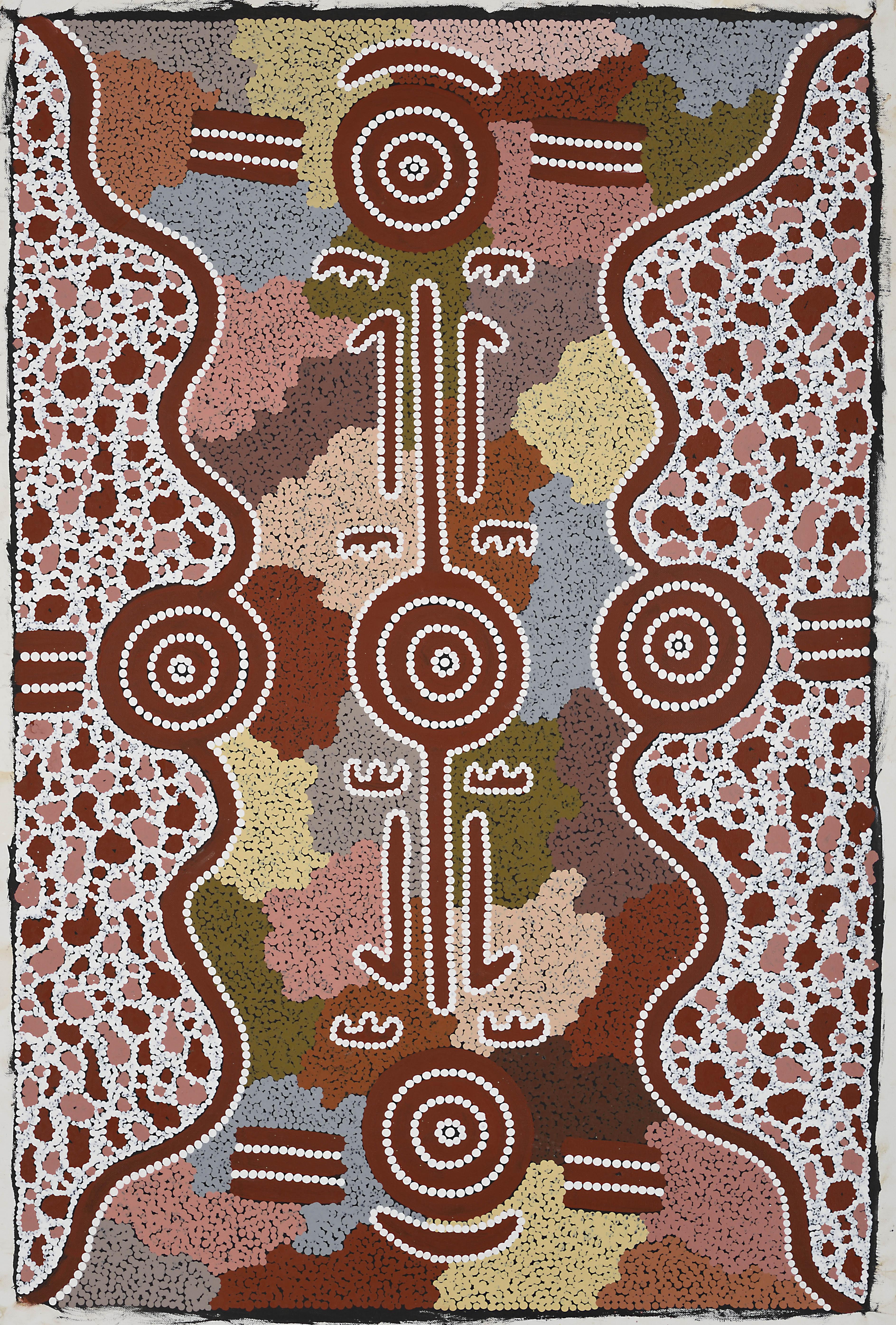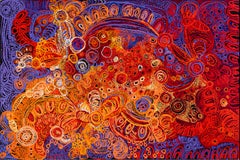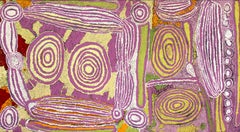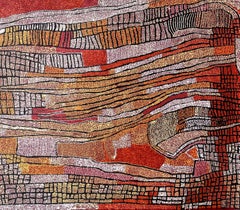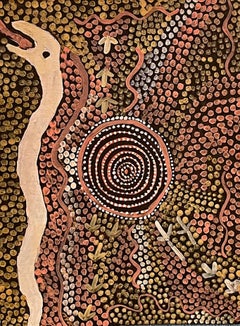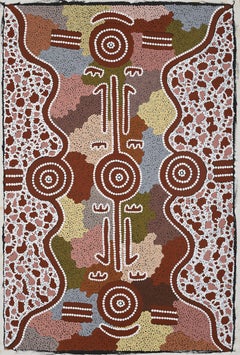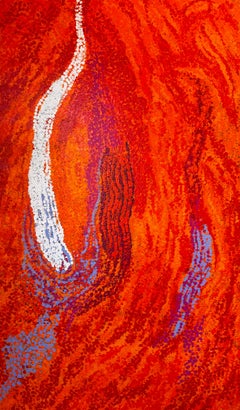Items Similar to Yannima Tommy Watson "Ngayuku Ngura" - 91x122 cm -2013 - Aboriginal Art
Video Loading
Want more images or videos?
Request additional images or videos from the seller
1 of 7
Yannima Tommy WatsonYannima Tommy Watson "Ngayuku Ngura" - 91x122 cm -2013 - Aboriginal Art2013
2013
$29,000
£22,071.32
€25,272.32
CA$41,247.83
A$45,187.92
CHF 23,605.28
MX$543,250.01
NOK 295,107.09
SEK 278,333.01
DKK 188,670.11
About the Item
Artist: Tommy Watson Yannima Pikarli (c.1935-2017)
size: 91x122cm
year: 2013
Acrylic on linen
Aboriginal Art
Provenance:
Yanda Art, Australia (certificat)
Aborigène Galerie Paris, Nicolas Andrin (certificat)
Collections:
Musée du Quai Branly, Paris
Art Gallery of New South Wales, Sydney
National Museum of Australie, Canberra
National Gallery of Victoria, Melbourne
National Gallery of Australia, Canberra
Western Australian Art Gallery, Perth
South Australian Art Gallery, Adelaide
Museum and Art Gallery of the Northern Territory, Darwin
Elizabeth and Colin Laverty, Sydney
Art Bank, Sydney
Patrick Corrigan, Sydney
Kerry Stokes Collection, Perth
2002/2003/2008 Finalist in Telstra National Aboriginal & Torres Strait Islander Art Awards
Yannima Tommy Watson, also known as Tommy Yannima Pikarli Watson, was a renowned Australian Aboriginal artist from the Pitjantjatjara people.
Born around 1935 in Anumarapiti, approximately 75 kilometers west of Irrunytju (also known as Wingellina) in Western Australia, he passed away in November 2017 in Alice Springs.
Orphaned at a young age—his mother died during his childhood and his father when he was around eight—Watson was raised by his paternal uncle and later by Nicodemus Watson, his father’s first cousin. It was during this time that he adopted the surname Watson in addition to his Aboriginal names, becoming Tommy Yannima Pikarli Watson.
Watson spent his youth traveling through the desert, learning traditional survival skills such as making tools and weapons, hunting, and finding water. These skills were closely tied to the ancestral stories of his people, known as Tjukurrpa.
He began painting in 2001 and quickly became one of the most innovative Aboriginal artists, recognized for his bold use of vibrant colors to symbolically represent the ancestral narratives of his homeland. Judith Ryan, Senior Curator of Indigenous Art at the National Gallery of Victoria, described Watson's colors as “incandescent.” His work was associated with the “Colour Power” movement that developed in the Indigenous art scene between 1984 and 2004.
One of his most notable contributions is a fresco adorning one of the ceilings of the Musée du Quai Branly in Paris, a testament to the international recognition of his art. His works are part of prestigious collections, including the National Gallery of Australia, the National Gallery of Victoria, and the Art Gallery of New South Wales.
Tommy Watson left a lasting legacy as a master of color and a storyteller of his people’s ancestral heritage, making a significant contribution to the preservation and dissemination of Aboriginal culture through contemporary art.
- Creator:Yannima Tommy Watson (1935, Australian)
- Creation Year:2013
- Dimensions:Height: 35.83 in (91 cm)Width: 0.99 in (2.5 cm)Depth: 60.24 in (153 cm)
- Medium:
- Movement & Style:
- Period:
- Condition:
- Gallery Location:PARIS, FR
- Reference Number:1stDibs: LU2847216121822
About the Seller
No Reviews Yet
Vetted Professional Seller
Every seller passes strict standards for authenticity and reliability
1stDibs seller since 2025
- ShippingRetrieving quote...Shipping from: PARIS, France
- Return Policy
Authenticity Guarantee
In the unlikely event there’s an issue with an item’s authenticity, contact us within 1 year for a full refund. DetailsMoney-Back Guarantee
If your item is not as described, is damaged in transit, or does not arrive, contact us within 7 days for a full refund. Details24-Hour Cancellation
You have a 24-hour grace period in which to reconsider your purchase, with no questions asked.Vetted Professional Sellers
Our world-class sellers must adhere to strict standards for service and quality, maintaining the integrity of our listings.Price-Match Guarantee
If you find that a seller listed the same item for a lower price elsewhere, we’ll match it.Trusted Global Delivery
Our best-in-class carrier network provides specialized shipping options worldwide, including custom delivery.More From This Seller
View AllRhoda Tjitayi "Piltati Tjukurpa" 200x300cm - 2021 - Aboriginal Art
Located in PARIS, FR
Artist: RHODA TJITAYI, (1969 -),
Titre: Piltati Tjukurpa
200x300 cm - 2021
Acrylique on canvas
réf:15021AS
Biography:
Rhoda Tjitayi’s monumental paintings reflect the richness of...
Category
21st Century and Contemporary Contemporary Abstract Paintings
Materials
Acrylic
Rhoda Tjitayi "Piltati Tjukurpa" 200x300cm - 2021 - Aboriginal Art
Located in PARIS, FR
Artist: RHODA TJITAYI, (1969 -),
Titre: Piltati Tjukurpa
200x300 cm - 2021
Acrylique on canvas
From Art Centre
réf:15021AS
Aboriginal Art
Biography:
Rhoda Tjitayi’s monumental p...
Category
21st Century and Contemporary Contemporary Abstract Paintings
Materials
Acrylic
Wingu Tingima "Kungkarrakalpa" 110x203cm - 2006 Aboriginal art
Located in PARIS, FR
Wingu Tingima (c.1920–2010)
"Kungkarrakalpa"
110x203cm - 2006
Acrylic on linen
Aboriginal art
Provenance:
Certificate of authenticity from arts centre
Biography
Wingu Tingima ...
Category
Early 2000s Abstract Abstract Paintings
Materials
Acrylic
Johnny Warangkula Tjupurrula " Egret Dreaming " 90x155cm - 1998 Aboriginal Art
Located in PARIS, FR
Johnny Warangkula Tjupurrula (c.1925-2001)
Titled: « Egret Dreaming »
dim: 90x155cm year 1998
Acrylic on canvas
Aboriginal Art
Johnny Warangkula Tjupurrula (c. 1925 – February 1...
Category
1990s Abstract Abstract Paintings
Materials
Acrylic
Rover Joolama Thomas "Marumaru" (Black One) Aboriginal Art 60x90 cm 1996
By Rover Thomas Joolama
Located in PARIS, FR
Rover Thomas Joolama (c.1926-1998)
Title: "Marumaru" (Black One)
Dimensions: 60x90 cm - Year: 1996
Natural pigments on linen canvas
Provenance: Art Centre Warmun (Stamp back...
Category
20th Century Contemporary Paintings
Materials
Pigment
Nyurapayia Nampitjinpa (Mrs Bennett) "Tjalili" 102x122cm - 2005 aboriginal art
Located in PARIS, FR
Nyurapayia Nampitjinpa (Mrs Bennett)
Titled: "Tjalili"
102x122cm - year 2005
Acrylic on canvas
aboriginal art
Biography
Nyurapayia Nampitjinpa, also known as Mrs Bennett, was a...
Category
21st Century and Contemporary Contemporary Paintings
Materials
Acrylic
You May Also Like
Large Stunning Australian Aboriginal Painting by Naata Nungurrayi
By Naata Nungurrayi
Located in Atlanta, GA
A large and stunning contemporary abstract painting by celebrated Australian Aboriginal artist Naata Nungurrayi (1932-2021), stretched and ready for display. A rare masterpiece of the museum quality dating from the peak of the artist's creative output in 2003. The canvas is singular in both the impressive size and tine quality, and it comes with full provenance and step by step photos (100 in total) recording the creation of this significant piece of work.
The artist used fine dots as the sole element to compose a complex dreamtime landscape where Women's Ceremony took place in her ancestral time. The place is located at Marrapinti and its surrounds, where many water soakage holes were located. Dots in brilliant shifting and contrasting colors form ceremonial Tingari symbols performed by the women, black crawling tracks that may be associated with a site called Karilywarra (two carpet snakes) and mesmerizing Tali (sandhill) movements surrounding the canvas. The work is of the signature style of the artist, singular and easily recognizable. The fine quality of this work is exemplary.
Medium: acrylic on Belgium Linen
Cat no. NN200315
Provenance: Yanda Aboriginal Art, NT.
The painting comes with a COA letter and an artist biograph issued by Yanda Aboriginal Art and a presentation album with 100 photos that documented the entire process of the creation of this large work of art. The edge of the painting bears name of the artist as well as the stamp of the gallery as shown.
Reference and further reading:
For a relevant work by the artist, See Plate 88 and Page 220-222 in the book "Past and Present Together: Fifty Years of Papunya Tula Artists" by Meyers and Skerritt.
Another similar work is illustrated on plate 13 in "Pintupi" by Hamiltons.
Artist's biography:
Naata Nungurrayi (1932-2021) is an Australian Aboriginal artist who was born at the site of Kumil, west of the Pollock Hills in Western Australia. She is from the Pintupi group from Kintore, Northern Territory and is one of the senior elders of the Kintore women artist movement. Naata is the sister of George Tjungurrayi and Nancy Nungurrayi, and her son is Kenny Williams Tjampitjinpa...
Category
21st Century and Contemporary Australian Modern Paintings
Materials
Canvas
Aboriginal painting on canvas board by Johnny Warangkula
Located in Miami, FL
Johnny Warangkula Tjupurrula
1925 - 2001
Born : Mintjilpirri, Kintore, NT
Language group : Pintupi/Warlpiri
Community : Papunya, NT
Johnny Warangkula Tjupurrula was born in 1925 at ...
Category
1970s Abstract Abstract Paintings
Materials
Cotton Canvas, Polymer
Aboriginal Painting by Michael Nelson Tjakamarra
By Michael Nelson Tjakamarra
Located in Miami, FL
Michael Nelson Tjakamarra (also cited as: Michael Nelson Jagamarra, or Jakamara) is a Senior Warlpiri Tribesman and an Elder of the Papunya Community in central Australia. Born c. 1949 at Pikilyi, Vaughan Springs west of Yuendumu in the Northern Territory, he grew up ‘in the bush’. His father was an important tribal elder and medicine man at Yuendumu. It was therefore automatic that he would grow up with the traditional values and knowledge that now influences his paintings.
Michael lived at Haasts Bluff until his parents took him to Yuendumu for European education at the mission school. He left school at thirteen, after initiation, and worked at buffalo shooting, driving trucks, droving cattle and in the army, before returning to Yuendumu and then to Papunya to settle in 1976. He worked for a time in the Government store and for the Council.
Michael learned to paint at Papunya by observing the senior men such as Billy Stockman and Old Mick Tjakamarra. Although he was tutored by his uncle, Jack Tjupurrula, Michael developed his own style and began painting earnestly from 1983.
Michael is known as master desert painter for his depiction of several Dreamings in one painting. For him the understanding of the Dreaming stories that go with his paintings is all important – without the stories his paintings would ‘mean nothing’ as far as he is concerned. His Dreamings include the Possum, Snake, Two Kangaroos, Rock Wallaby, Bush Banana, Honey Ant and Yam.
In 1984 Michael won the National Aboriginal Art Award with his painting ‘Three Dreamings’. His reputation as a painter rose rapidly after this. He exhibited his work in the 1986 Biennale of Sydney and featured in ‘The State of the Art’, a British art documentary. In 1987 Michael had been asked to paint a major work (27’long) to decorate the foyer of Sydney’s Opera House and he chose to paint his ‘Possum Dreaming’ story. A great highlight in Michael’s career was in 1988 when he was commissioned to design a 196 sq-metre mosaic in the main forecourt of Australia’s new Parliament House in Canberra. The work was based on his ‘Kangaroo and Emu’ dreaming. Michael was presented to Her Majesty, Queen Elizabeth 11...
Category
2010s Contemporary Abstract Paintings
Materials
Linen, Acrylic
Ngayuku Kgura (My Country)
By Yannima Tommy Watson
Located in Miami, FL
Yannima Tommy Watson is a Pitjantjatjara artist born around the 1930s, in the bush some 44km west of the small isolated community of Irrunytju. Not yet very well known to the French public, despite his participation in the architectural project of the Musée du Quai Branly, Tommy Watson is nevertheless often considered the greatest living Aboriginal artist.
Like many aborigines of his generation, he lived a traditional, nomadic or semi-nomadic life before his contact with Western civilization; then he will occupy the only jobs that the Aborigines find: herdsmen (until Yuendumu), laborers for the construction of infrastructures in the desert. Throughout this period he became familiar with his "country", a harsh region, and deepened his knowledge, both profane and sacred, relating to Dreams and Dreamtimes, to the connections between sacred sites and the Ancestors. He will even work in Papunya, where the artistic movement started. But the Pijantjarra are intransigent with tradition…no question at this time of revealing the motives and the secret stories.
The North of South Australia, the region where he is from, was touched by the pictorial movement only at the very beginning of the 2000s. In 2001, Tommy began his career as an artist in Irrunytju (Wingellina). He is a young artist… He learns by observing other painters and draws on the experiences of a long life and on the exceptional knowledge he has stored up. But quickly he will find his way, a radically new style where color plays a major role. Very quickly, the iconography now well known by the artists of Yuendumu, or the Western Desert, Balgo or Lajamanu disappeared. The symbols are no longer there. As Rover Thomas, Emily Kame or Paddy Bedford had done before him, this is a real artistic revolution. For Tommy, it is not a question of describing his Dream (Caterpillar), the routes taken by the Ancestors. He concentrates on a site, a story, sometimes very profane, the memory of a meeting, of a hunting party, tries to condense his memories, the information of which he is the depositary, to add a poetic touch to it, sometimes melancholy, and this gives a painting with a very abstract aspect. It is a painting where the emotion is very present, undoubtedly less cerebral than the art of the neighbors of the north the Pintupi, like Ronnie Tjampitjinpa, George...
Category
2010s Contemporary Abstract Paintings
Materials
Linen, Cotton Canvas, Acrylic
Tjintjintjin
By Walangkura Napanangka
Located in Miami, FL
As one of the last generation to remember a childhood lived in the desert hunting and gathering with her family, Walangkura Napanangka's paintings recall the stories of country and the location of specific sites in her traditional homeland west of the salt lake of Karrkurutinjinya (Lake Macdonald).
Born around 1946, at Tjitururrnga west of Kintore, in the remote and arid country between the Northern Territory and Western Australia, she lived with her father Rantji Tjapangati and mother Inyuwa Nampitjinpa and later, while still a teenager, travelled by foot with her family over the hundreds of kilometres from their remote desert home eventually joining Uta Uta Tjangala's group as they walked in to the settlements of Haasts Bluff and then Papunya.
The lure of settlement life with its promise of plentiful food and water belied the harsh conversion they would make to an alien lifestyle with its many problems and unfamiliar demands. The upheaval however, was ameliorated to some degree by the proximity of her immediate family including her mother Inyuwa, adoptive father Tutuma Tjapangati, and sister Pirrmangka Napanangka (now deceased) all of whom became artists.
Relocated to the community of Kintore in 1981 when the outstation movement began, Walangkura participated in the historic women's collaborative painting project (1994) that was initiated by the older women as a means of re-affirming their own spiritual and ancestral roots. It was a time of specifically female singing, ceremony and painting, away from the gaze of outsiders and men folk. The huge and colourful canvases that emerged from the women's camp were 'alive with the ritual excitement and narrative intensity of the occasion' (Johnson 2000: 197).
Within a year, Papunya Tula Artists, now established at Kintore, had taken on many of these women as full-time artists, revitalising the company after the deaths of many of the original 'painting men'. While individual women forged their own stylistic trajectory, these paintings were immediately distinguishable from the men's more cerebral and symmetrical style. They radiated an exuberant and vibrant energy, the felt heart-beat of women's affinity to country and spirit.
Walangkura's early works, created from 1996 onward, are characterized by masses of small markings and motifs covering large areas of canvas. Her favorite colour, a deep sandy orange predominates, accentuated against more somber blacks and reds and dusky greens or yellows. More recent works show a gestural quality though still tightly packed with an intensity of geometric line work representing sandhills. In a sense this provides a strong visual and contextual link to the men's linear style as exemplified by the works of George Tjungurrayi...
Category
2010s Contemporary Abstract Paintings
Materials
Linen, Cotton Canvas, Acrylic
Large Aboriginal Painting "Wati Kutjara" by Yannima Tommy Watson
Located in Atlanta, GA
A large and striking aboriginal painting by celebrated Australian artist Yannima Tommy Watson (1935s-2017; Pitjantjatjara people from Australia's central western desert). Stretched and ready to display (no frame).
Medium: Acrylic on canvas
Year of Creation: 2013
Title: Wati Kutjara
An important aboriginal dreamtime story from the Western Australia (the song line is also known as Two Men Dreaming), the narrative is about two young lizard-men travelling all over the Western Desert. They covered a vast landscape from Kimberley in the north to Southern Australia. The two brothers often took the form of wind and left songs in their epic journey to enlighten the people they encountered with rituals and knowledge. As magical ancestral beings, they destroyed evil spirits and created sacred objects across all over the Western Dessert.
Provenance:
Agathon Galleries, Melbourne 2013
Art Yarramunua, Melbourne (accompanied by a certificate of authenticity)
Private Collection, Melbourne 2017
About the artist (courtesy of Kate Owen and Japingka Gallery)
Yannima Tommy Watson was a celebrated Pitjantjatara artist, born around 1935 in the desert west of Irrunytju in Western Australia. Tommy was a Law man of Karima skin group, and his traditional names were Yannima and Pikarli relate to specific sites near his birthplace at Anumarapiti, west of Irrunytju.
As a young man Tommy learned the bush skills of hunting and gathering, living off the land. In these years his physical and spiritual knowledge of the land was deeply embedded in his life.
Tommy Watson first met white people at Ernabella Mission in the 1940s. He then spent decades working as a stockman and laborer on cattle stations. Not until 2001 when he was in his mid 60s, did Tommy Watson pick up a paint brush and painted his first picture at Irrunytju art center established by a small group of artists.
Watson's work became quickly recognized for his powerful use of colors and his mesmerizing creation of energetic movement. He exhibited in Alice Springs at Desert Mob and as a finalist at the Telstra NATSIAA Art Awards in Darwin. With his work becoming highly collectable, Tommy soon entered into an exclusive representation agreement with Jon Ioannou of Agathon Gallery. This arrangement marked the start of a second phase of Tommy's career and saw the creation of a large body of outstanding artworks which were to further propel Tommy into the upper echelons of Australian indigenous artists. This painting was created toward the end of that phase.
In 2005, Tommy was commissioned, along with Ningura Napurrula, Lena Nyadbi, Michael Riley, Judy Watson, John Mawurndjul, Paddy Bedford...
Category
2010s Australian Modern Paintings
Materials
Canvas
More Ways To Browse
Toma Stenko
Used Jazz Guitars
Vintage Chemistry Art
Vintage Cycling Signs
W Adam Original Oil Painting
Walter Gutman
William Quinn
100 Dollar Art
36 X 42 Painting
48x48 Hunt Slonem
Abstract Art With Words
Abstract Blue Splatter Paintings
Abstract Painting Eiffel Tower
Abstract With Words Painting
Amigo Oil Painting
Andrew Hudson
Angela Lane
Anthony Finta
